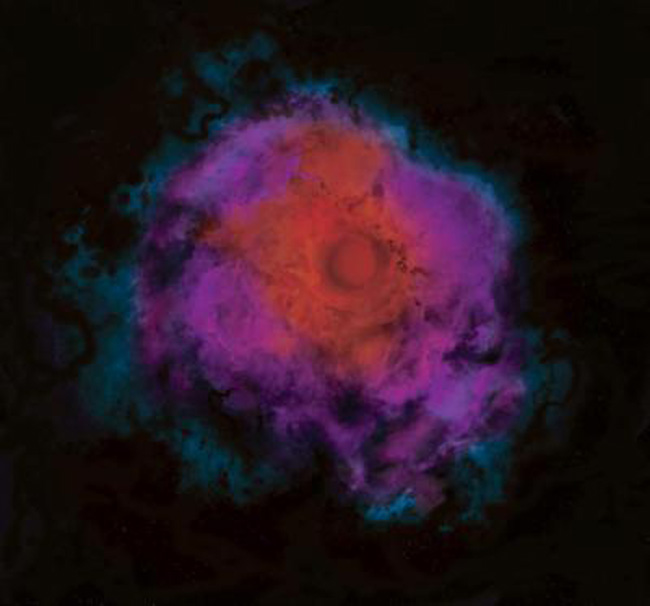Dark Matter Stars Could Solve Cosmic Mystery

In the early universe, the first stars may have been madenot of regular matter, but of its mysterious cousin, dark matter. But exactlyhow it all happened remains a mystery, and figuring it out could helpastronomers understand dark matter itself.
Dark matter is the pesky substance thought to permeate theuniverse that stubbornly refuses to show itself to telescopes or any otherdirect detection method scientists can throw at it. Yet researchers can senseit lurking by the gravitational pull dark matter exerts on normal stars andgalaxies.
There are many competing theories about what dark matter isactually made of, and each suggestion comes with slightly different propertiesand implications. Now, a new study calculated which possible forms of dark mattercould lead to so-called darkstars.
Not really dark
"Not all kinds of dark matter would be able to formdark stars," said study leader Paolo Gondolo of the University of Utah. "Inthis sense dark stars are a tool to understand the nature of dark matter."[Video:Dark Matter in 3-D]
The term dark star is somewhat misleading, he said, becausein fact these stars would emit light and would be visible. But the matter thatreacts in the star's core to form that light would be darkmatter, not regular matter.
Though dark stars have not yet been observed by telescopes,some experts think future observatories like the James Webb Space Telescope, asuccessor to the Hubble Space Telescope, set to launch in 2014, could be up tothe job.
Get the Space.com Newsletter
Breaking space news, the latest updates on rocket launches, skywatching events and more!
"If we detect evidence of dark stars, or if we can saythat there are no dark stars, then they present constraints" on what darkmatter is made of, Gondolo told SPACE.com.
What makes a star?
Many dark matter candidate particles are their ownantimatter partner, which means if two particles come close enough together,they will annihilate to produce energy, some of which is emitted in the form oflight.
Today, with the universe spread out, matter is not packedtightly enough for dark matter particles to be condensed to the point ofannihilating. But after the Big Bang when the universe was young andcomparatively small, the conditions were right for dark stars.
Dark matter would only form a very small fraction of thetotal mass of such stars ? the rest would be normal matter. But the dark matterannihilation process is very efficient, because colliding dark particles wouldconvert all of their mass to energy via Einstein's equation, E=mc2.
Thus dark stars would shine quite bright.
Eventually, when the dark matter supply inside the star wasexhausted, normal matter would condense to begin the regular process of nuclearfusion that fuels most stars. Some of these could still be around today.
A few good candidates
One popular candidate for the stuff that makes up darkmatter is an elementary particle called the axion. These hypothetical particlesare predicted by theory, but have never been detected.
They would have no electric charge, a small mass, and wouldbe very resistant to interact with ordinary matter ? a key qualification thatmakes some scientists suspect they are the culprit behind dark matter.
"We find that axions are not good to form darkstars," Gondolo said. Their particular characteristics are not suitablefor reacting in the way it would take to power stars. That means that if darkstars are ever observed, axions may be out as a candidate.
Another possibility is a hypothetical category of particlescalled WIMPs(weakly interacting massive particles). These would be quite heavy ? whichcould help explain why dark matter accounts for about 98 percent of all thematter in the universe, scientists think.
The weakly interacting part denotes their standoffish nature? they would rarely react with other particles ? again, another requirement ifthey are the stuffof dark matter.
Some WIMPS, it turns out, would be good at forming darkstars. One type, a particle called the neutralino, is predicted by thesupersymmetric theory, which posits that every particle has a symmetric partnerparticle that we haven't yet discovered.
One kind of neutralino, the photino (the partner of thephoton) would be the lightest ? and therefore the easiest to detect ? of thesepartners.
"Neutralinos can produce dark stars, with very fewexceptions," Gondolo said.
The findings were published in a recent issue of the Journalof Cosmology and Astroparticle Physics.
- 10 Enduring Star Mysteries
- Video: Dark Matter in 3-D
- Dark Energy and Dark Matter Might Not Exist, Scientists Allege
Join our Space Forums to keep talking space on the latest missions, night sky and more! And if you have a news tip, correction or comment, let us know at: community@space.com.

Clara Moskowitz is a science and space writer who joined the Space.com team in 2008 and served as Assistant Managing Editor from 2011 to 2013. Clara has a bachelor's degree in astronomy and physics from Wesleyan University, and a graduate certificate in science writing from the University of California, Santa Cruz. She covers everything from astronomy to human spaceflight and once aced a NASTAR suborbital spaceflight training program for space missions. Clara is currently Associate Editor of Scientific American. To see her latest project is, follow Clara on Twitter.









